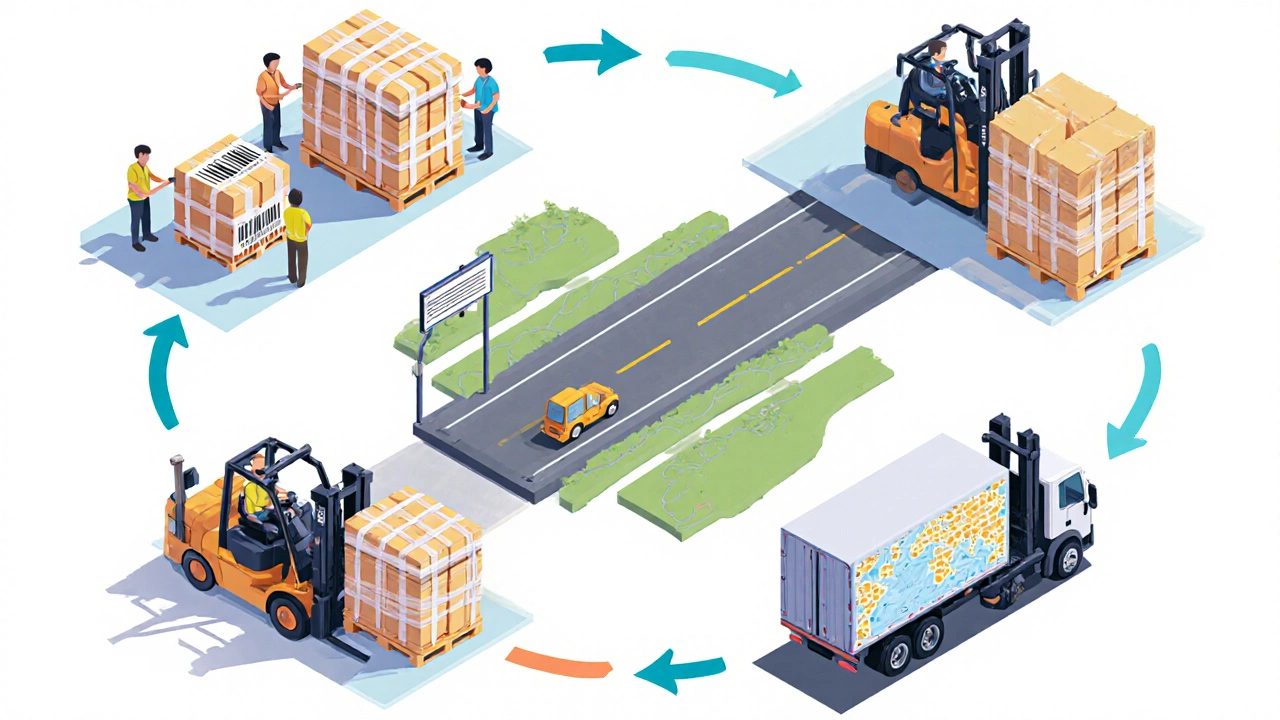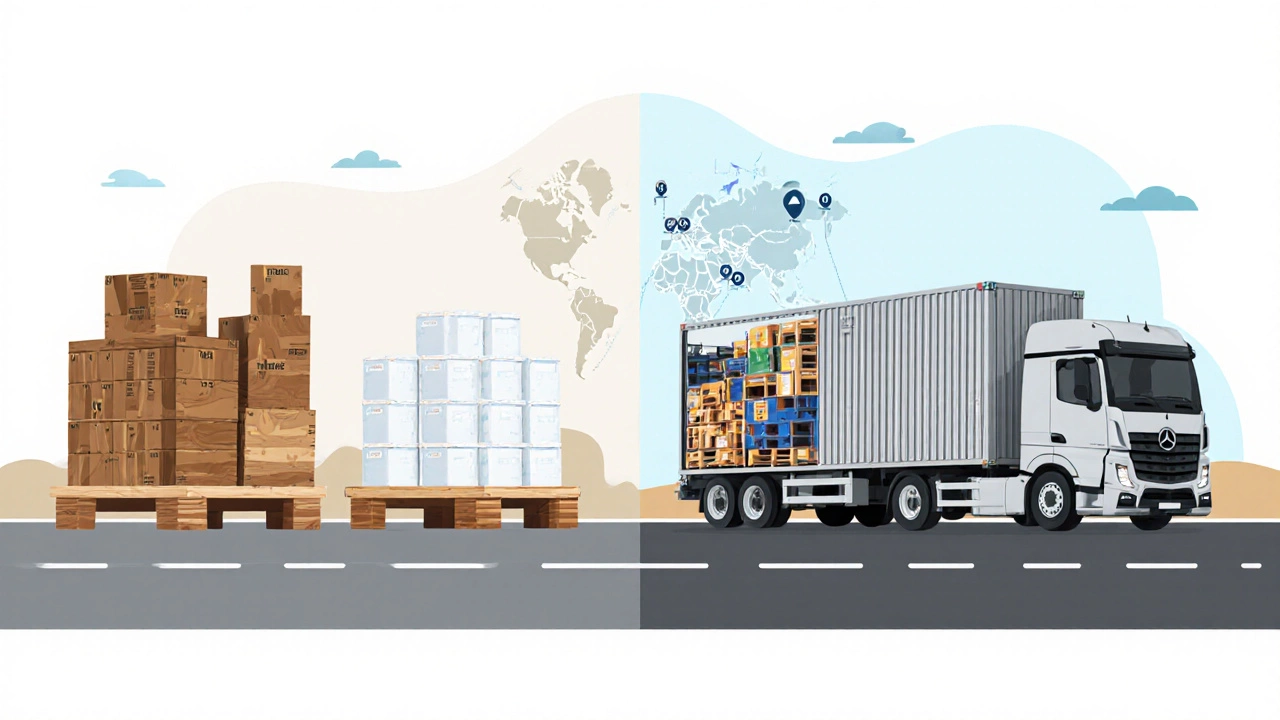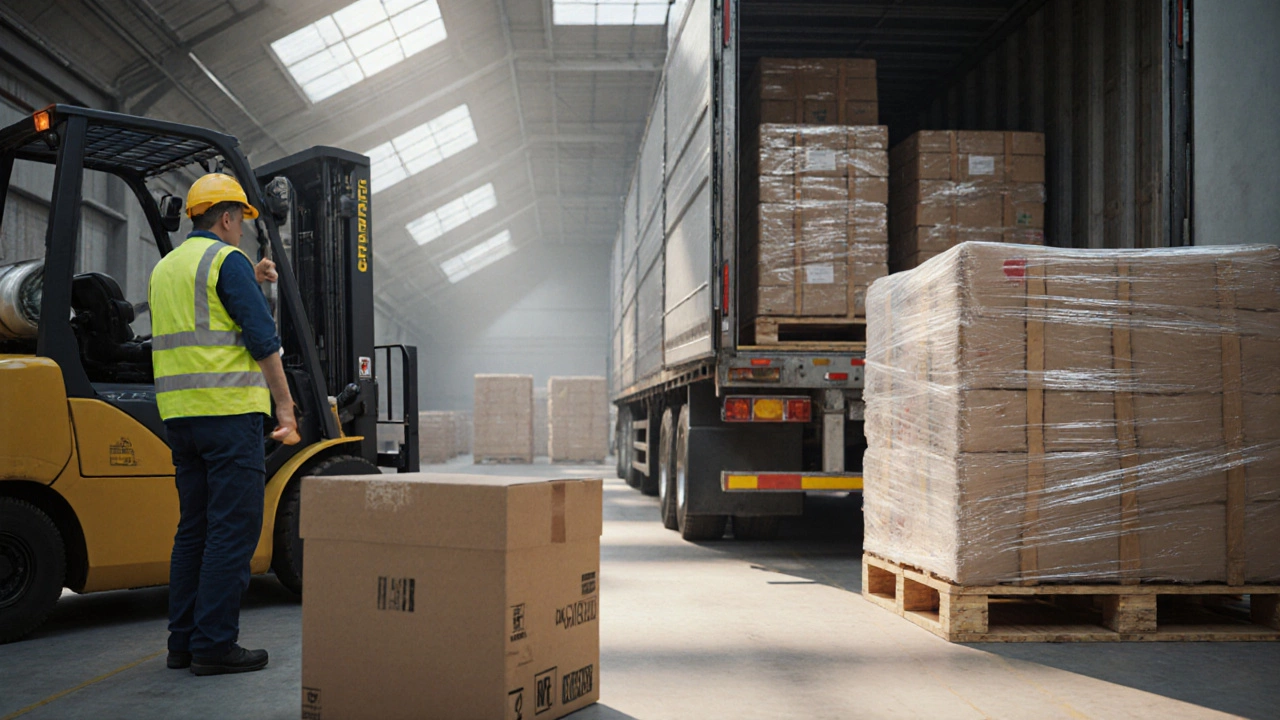Pallet Delivery Cost Calculator
Estimated Delivery Cost
Ever stared at a big cardboard box and wondered why some businesses swear by wooden platforms stacked on trucks? The answer lies in the humble pallet delivery. It’s the backbone of moving bulk goods efficiently across the UK and beyond.
What is a pallet delivery?
pallet delivery is a logistics service where goods are placed on standardized pallets and transported as a single unit from a shipper to a receiver. This method replaces loose handling of individual boxes, cuts loading time, and reduces damage.
How a pallet delivery works - step by step
- **Pick and pack** - The warehouse staff stack items on a pallet, securing them with stretch wrap or straps.
- **Labeling** - A barcode or QR code featuring the shipment reference is attached to the pallet.
- **Load onto a truck** - The driver or dock crew slides the pallet onto a forklift and places it into the trailer.
- **Transit** - Depending on distance and urgency, the pallet travels via full truckload (FTL) or less‑than‑truckload (LTL) routes.
- **Delivery** - At the destination, the pallet is moved to the loading dock and un‑wrapped for unloading.
Each step relies on a few core pieces of equipment and terminology.
Key pieces of equipment
When you hear the word pallet, picture a flat wooden or plastic platform about 1.2m×1.0m in the UK. Pallets come in three main flavours:
- Wooden pallets - Most common, reusable, and cheap.
- Plastic pallets - Light, waterproof, great for food or chemicals.
- Metal pallets - Used for heavy‑duty or hazardous loads.
Choosing the right pallet type can affect weight limits, cost, and the need for cleaning.

Delivery methods: FTL vs LTL
full truckload (FTL) means an entire trailer is dedicated to your pallets. It’s ideal for large orders, offers faster transit, and reduces handling risk.
less‑than‑truckload (LTL) consolidates multiple shippers’ pallets in one trailer. It’s cheaper for smaller shipments but adds extra stops and handling points.
Most UK businesses use a mix of both, picking the method that matches order size and delivery windows.
Cost factors you need to watch
Several variables drive the price of a pallet delivery:
- Distance - Longer hauls naturally cost more. A 200km run from Liverpool to Manchester averages £1.20 per pallet.
- Weight and dimensions - Heavier pallets may require a higher‑capacity vehicle.
- Service level - Same‑day or time‑definite deliveries add a premium (often 20‑30%).
- Pallet type - Plastic pallets can add £0.30 per unit compared to wood.
- Fuel surcharge - Adjusts monthly based on the UK diesel price index.
Getting a detailed quote from a logistics provider helps avoid surprise fees.
Benefits of using pallet delivery
Why do thousands of UK manufacturers stick with pallets?
- Speed - One forklift can load dozens of pallets in minutes.
- Safety - Reduces manual lifting, lowering injury risk.
- Damage reduction - Items stay secured, less chance of drops.
- Space efficiency - Pallets pack tightly, maximizing trailer capacity.
- Scalability - Easy to add more pallets as demand grows.
Common challenges and how to avoid them
Even a well‑planned pallet delivery can hit snags. Here are the usual culprits and quick fixes:
- Mismatched pallet size - Verify your supplier uses the UK standard (1200mm×1000mm). A size mismatch can cause wasted space or loading delays.
- Pallet damage - Inspect pallets before loading. Replace broken boards to prevent collapse mid‑journey.
- Improper wrapping - Use high‑stretch film and secure all edges. Loose wraps lead to shifting and product damage.
- Scheduling conflicts - Align your dispatch window with the carrier’s arrival slot. Most UK docks operate a strict 30‑minute grace period.
- Documentation errors - Double‑check the barcode/QR code matches the shipment manifest. Scanning errors cause delays at customs for international freight.

Choosing the right logistics provider
Not all carriers handle pallets equally. Keep an eye on these criteria:
- Network coverage - Does the provider serve your key routes (e.g., North‑South UK corridors)?
- Equipment fleet - Look for modern forklifts and pallet‑compatible trailers.
- Insurance options - Ensure coverage for both goods and pallets.
- Tracking technology - Real‑time GPS and barcode scanning give visibility.
- Customer reviews - Recent testimonials from similar sized businesses are gold.
Request a pilot shipment before signing a long‑term contract to gauge reliability.
Pallet delivery checklist
- Confirm pallet dimensions and type.
- Secure items with stretch wrap or straps.
- Attach accurate barcode/QR label.
- Verify carrier’s FTL/LTL selection.
- Schedule delivery window with the loading dock team.
- Review insurance and service level agreement.
- Track shipment and confirm receipt.
Comparison: Pallet Delivery vs Parcel Delivery
| Aspect | Pallet Delivery | Parcel Delivery |
|---|---|---|
| Typical weight per unit | 50kg-1000kg | 0.1kg-30kg |
| Handling equipment | Forklift, pallet jack | Hand‑carried, small cart |
| Service speed | Same‑day to several days (depends on FTL/LTL) | Next‑day, same‑day possible |
| Cost per unit | £0.80-£2.50 (varies by distance) | £3-£10 (small items) |
| Damage risk | Low (secured on pallet) | Higher (multiple handling points) |
Frequently Asked Questions
What size pallets are standard in the UK?
The most common UK standard is 1200mm×1000mm (EU‑standard). Some industries also use 800mm×600mm for smaller items.
Can I ship mixed‑type pallets in the same truck?
Yes, as long as the carrier’s weight and dimension limits aren’t exceeded. Mixing wood and plastic pallets is common, but keep them separated for inventory tracking.
How do I calculate the cost of a pallet delivery?
Start with base rate per kilometre, add weight surcharge, fuel surcharge, and any optional services (e.g., same‑day). Most providers supply an online calculator where you input: distance, pallet count, weight, and service level.
Is pallet delivery suitable for perishable goods?
Yes, if you use insulated or refrigerated pallets and choose a carrier offering temperature‑controlled transport. Always confirm the carrier’s compliance with UK food‑safety regulations.
What paperwork do I need for a domestic pallet shipment?
A standard freight invoice, a packing list, and a Bill of Lading (or Consignment Note). If the goods are high‑value, add insurance documentation.


